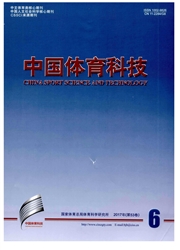

 中文摘要:
中文摘要:
目的:对比分析短期终止训练和持续大强度训练对游泳运动员气道反应性和肺通气功能的影响,结合分析相关炎性因子的变化,研究游泳运动员运动诱发支气管痉挛的可复性。方法:以36名青少年游泳运动员为研究对象,平均年龄15.97±1.1岁。其中,15名运动员终止训练或低强度恢复性训练为期2周,为实验组;选取同一教练组,正常强度训练的21名运动员为对照组。分别于2周前后进行肺功能测试和支气管激发试验。测试日晨起肘正中静脉采血,测试血常规及血清Ig E、IL-17。结果:1)首次测试,共检出13名运动员EIB阳性(36%),实验组5人(33%)、对照组8人(38%),组间比较无显著性差异;2)首次测试13名EIB阳性运动员中仅有5人出现哮喘类呼吸症状(EIA),实验组2人(13%)、对照组3人(14%),组间比较无显著性差异;3)停训2周后,实验组3名EIB阳性运动员转为阴性,EIB检出率显著低于对照组(20%vs.48%,P〈0.05);实验组运动员支气管激发试验FEV1下降百分比显著降低(10.53±8.19 vs.8.35±5.24,P〈0.05),而肺功能参数MEF50%显著升高(88.69±27.01 vs.91.13±26.93,P〈0.05);4)停训2周后,实验组运动员静脉血中性粒细胞计数(3.47±1.06 vs.3.13±0.97,P〈0.05)和中性粒细胞百分比(55.31±7.60 vs.51.25±8.31,P〈0.05)均显著降低,静脉血中性粒细胞计数显著低于对照组(3.13±0.97 vs.3.39±0.91,P〈0.05);中性粒细胞计数同支气管激发试验FEV1下降百分比之间相关性不显著(r=0.323,P〉0.05);实验组运动员血清IL-17含量显著降低(0.98±0.21 vs.0.83±0.10,P〈0.05),而血清Ig E未发生显著变化。结论:1)游泳运动员EIB具有可复性,短期终止训练在一定程度上可以促进EIB的恢复;2)EIB阳性运动员多无哮喘类主观症状,支气管激发试验的客观证据是明确诊断的必要条件。
 英文摘要:
英文摘要:
Objective: To investigate the effect of training break on airway hyper-responsiveness and pulmonary function and to evaluate the reversibility of EIB in swimmers. Methods: Thirty-six adolescent swimmers (average age: 15.97±1.1 years ) participate in our research. All of the swimmers completed resting spirometry test and bronchial provocation test at baseline and follow-up. Fifteen of the swimmers who had stopped training more than 2 weeks before the follow-up exami- nation were selected as experimental group and twenty-one swimmers who had continued their intensity training were taken as control. Result: 1 ) Thirteen swimmers (36%) showed EIB at T1, five in experimental group (33%) and eight in control group (38%). There was no significant difference between groups. 2) Only five swimmers (14%) showed EIA at T1, two in experimental group (13%) and three in control group (14%). There was no significant difference between groups. 3) After two weeks, there were 3 EIB positive athletes turned negative. The prevalence of EIB in experimental group was significantly lower than control (20% vs. 48%, P〈0.05). Significant decrease in declines of FEV, (10.53±8.19 vs. 8.35±5.24, P〈0.05) and significant rise in MEF50%(88.69±27.01 vs 91.13±26.93, P〈0.05)were observed in experimental group only. 4) After two weeks, significant decrease of percentage of neutrophils (55.31±7.60 vs. 51.25±8.31, P〈 0.05 ) and neutrophil count (3.47 ± 1.06 vs. 3.13 ± 0.97, P〈 0.05) were observed in experimental group. There was a significant difference in neutrophil count between groups (3.13±0.97 vs. 3.39± 0.91, P〈0.05). No relation was found between neutrophil count and the declines of FEVI (r= 0.323, P〉0.05). Neither group experienced any significant change in serum IgE. Conclusions: 1 ) Training may contribute to the development of airway hyperresponsiveness in swimmers and the EIB of swimmers is partly reversible. 2) The majority of swimmers wi
 同期刊论文项目
同期刊论文项目
 同项目期刊论文
同项目期刊论文
 期刊信息
期刊信息
